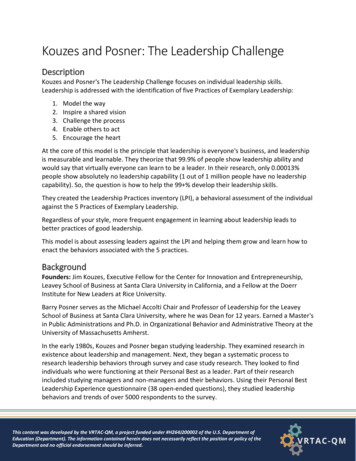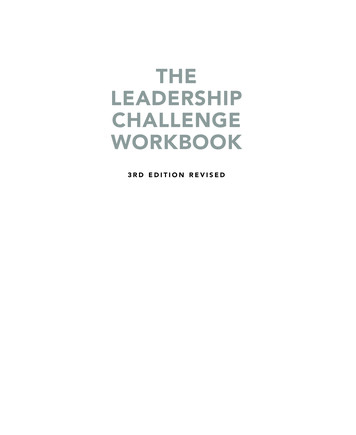
Transcription
The School LeadershipChallenge: 2022
The School Leadership Challenge: 2022Teach First, The Future Leaders Trust and Teaching Leaders have a joint mission to endeducational inequality. We believe that the right leadership in schools can transform expectationsfor disadvantaged pupils and equip them with skills that will enable success at school and on intothe workplace.We conducted this research into the supply of leaders in schools in England to discover theextent and cause of empty posts in these critical positions. Our report suggests that by 2022England could be in need of up to 19,000 school leaders.Our challenge is to fill this gap. We’re contributing by providing leadership development from thestart via Teach First’s Leadership Development Programme; and providing an integrated careerpathway for middle leaders to multi-academy trust chief executives via the upcoming merger ofTeaching Leaders and The Future Leaders Trust. This will accelerate more people to leadershiproles and we believe it will increase retention too. We must also encourage those to considerheadship who may have ruled it out – particularly under-represented groups including womenand Black, Asian and minority ethnic leaders.This report makes further recommendations on how to increase the school leadership pipelinethat we will work with the rest of the sector to achieve: Develop a new generation of leaders via more effective opportunities that encouragecareer progression to headshipExpand the pool of leaders, including welcoming executives from outside the professionChange sector culture to promote organised leadership development and progressionas a normRaise awareness of the positive impact of school leadersWe want to see people working in schools who are passionate about children achieving and havethe skills to make it happen. School leaders’ job is to create school environments where everyonecan flourish – children, teachers and budding school leaders.If we are to realise our vision of a society where every child achieves, we need excellent schoolleaders and this report finds that we need many more of them.Brett Wigdortz OBE, Founder and CEO of Teach FirstJames Toop, CEO of Teaching Leaders and The Future Leaders TrustNovember 2016
The School Leadership Challenge: 2022Summary‘The School Leadership Challenge’ provides an analysis of the supply and demand for school leadersuntil 2022. We know that schools in England face real challenges in attracting, developing and retainingleaders. Research found 40% of school governors face challenges in finding good candidates for seniorroles, forcing schools to create ad hoc, short-term solutions.In summer 2016, TeachFirst, Teaching Leaders and The Future Leaders Trust investigated the extent andcauses of these recruitment issues. The report delivers the first integrated, nation-wide view of the scaleand nature of this problem; more importantly it also presents solutions, highlighting successful initiatives inthe UK and elsewhere.The case for leadershipMuch existing, largely qualitative research identifies how school improvement and high performance arereliant on good leadership (Appendix, slide 5). In addition, analysis of Ofsted data shows that improvementis less likely without good leadership.A school where Ofsted rates leadership and management higher than overall performance is ten timesmore likely to improve its overall Ofsted rating at the next inspection than one where leadership andmanagement is rated worse than the overall performance. Of those where leadership and management israted worse, 40% declined in overall Ofsted performance at the next inspection (Appendix, slide 6).MethodologyData from Edubase and the School Workforce Census were used to calculate the supply ofheadteachers based on their historic growth in numbers, retirement rates, the age of teachersand those who leave the profession early. Data from the Office for National Statistics were used tocalculate the likely growth in student numbers and hence the demand for schools and thereforeschool leaders.In the analyses a school leader is an assistant head, deputy head, headteacher or head ofschool, executive headteacher or CEO.For this study, we do not include middle leadership because the School Workforce Census does notlist middle leaders as a separate category.1. Due to the data available, this research defines a ‘school leader’ as an assistant head, deputy head, headteacher or head of school,executive headteacher or CEO.2
The School Leadership Challenge: 2022The contextBy 2022, unless action is taken, the report projects that England may face a shortage of between 14,000and 19,000 school leaders (Appendix, slide 7), affecting almost one in four schools in England. Three factorsunderlie this: Increasing demand: Up to 8,000 new leaders may be needed to meet a growth in leadershippositions caused by an increased number of executive head and CEO roles in academy trusts. An existing issue: Based on the expectation that larger schools need more leaders, theresearch shows there is already a current need for 2,000-3,000 additional leaders in the system withsome being ‘over-stretched’ to fill the deficit. More leaders retiring or leaving: The supply of leaders is expected to fall by 8,000 due toretirement and leaders leaving the profession early. Half of the existing leadership pool is expected toleave education in the next six years.Currently secondary schools are most affected but by 2022 both primary and secondary schools across thecountry are likely be impacted, particularly those serving our most disadvantaged students.Schools with many disadvantaged students would be impacted disproportionatelyThe report projects this would be most severe in schools serving England’s most disadvantaged children.These schools make up 40% of all schools in England but are likely to face half of the leadership shortage.By 2022, our most challenged schools may need up to 10,000 more school leaders (Appendix, slide 11).That is equivalent to one missing leader in every school in a challenging context.The cost of school leadershipThe impact is already clear as schools are estimated to spend up to 200m per year on recruitment withmany failing to find the quality of candidate that they want. According to a NAHT survey covering 200leadership roles, over 30% of adverts for headteacher positions in 2015 received no applications (Appendix,slide 16).3
The School Leadership Challenge: 2022Four challenges for leadershipInterviews with stakeholders and quantitative analyses indicated four challenges to closing the leadershipgap (Appendix, slide 21):1. Potential headteacher applicants are deterred by the challenges of the role as it is currently andare not effectively incentivised to apply.Qualitative research found teachers are put off by high stakes accountability, the breadth of additionalresponsibilities and the distance from classroom teaching.There is a perception that the transition from deputy to headteacher comes with far greater accountabilitybut not a commensurate rise in pay. The salary is also weighted by number of students in the school andgeography, rather than the scale of the challenge.2. Recruitment of headteachers is inconsistent, affected by both a lack of candidates in particularareas, and inexperience in recruitment of headteacher roles.Governing bodies may lack experience of recruiting for key leadership roles; and so are over cautious inappointments.There is limited succession planning because demand is only identified at school level and few individualshave clear career pathways.Some schools find it particularly difficult to recruit because they are in highly deprived and/or isolated areas.The school type also limits the pool of applicants (e.g. faith schools).4
The School Leadership Challenge: 20223 . The profession lacks a culture of development and feedback with varied access toopportunities.Individual access to development opportunities varies greatly because the profession lacks a shared cultureof development and feedback.Identification of leadership potential is subjective, depending on individual headteachers. There is no centralmechanism to moderate postings, and available programmes vary in quality, with no consistent measure oftheir value.‘Technical’ skills training is also very limited, leading to an unmet appetite for basic management tools andstrategies and a reluctance to recognise external qualifications as relevant.4. Leaders do not get the support or feel the motivation that would keep them in leadership rolesand increase retention.The support individuals receive varies greatly. In some cases heads lack support from governing bodies, whomay, for example, focus on Ofsted reports for performance management.The availability of coaching, mentoring and peer review mechanisms is patchy. Single schools have noincentive to develop leaders who could move elsewhere and may not remain part of a broader network.There is no single, strong voice for development in the profession which could provide a framework for goodleadership, and no counterbalance to factors which may push leaders out of the profession such as: poorwork/life balance; radical change in the professional landscape; and pension changes.5
The School Leadership Challenge: 2022Finding the new leadersThe leadership pool is not representative of the teaching population. Compared to teachers, headteachersare older, less likely to be from Black, Asian and minority ethnic groups and less likely to be female(Appendix, slide 19). This under-representation suggests there are many potential leaders in the female andBAME workforce, so identifying these existing teachers could contribute to addressing the problem.With five years of experience, high-performing teachers can be ready to move into senior leadership. Thereare 240,000 teachers with this level of experience who are not in leadership roles and may also representuntapped potential.A structured career pathway of development could provide these ‘missing leaders’ with the support anddirection that will encourage and enable them to become school leaders.Working towards a solutionA literature review, a review of high-performing education systems and expert interviews identified clearcharacteristics of good practice (Appendix, slides 27-28). These included establishing clear careerpathways, cross-school succession planning and providing support for governing bodies who are makingappointments.There must also be a dramatic shift in the culture of schools. It should change to a culture that ensuresaspiring and existing leaders have access to personalised development combining academic and practicallearning, mentoring and coaching and peer-to-peer support networks.Our report proposes four interventions:1.Develop a new generation of school leaders2.Expand the pool of candidates for executive roles3.Drive system change to support leaders more effectively and provide clear career pathways4.Build the brand of school leadershipIn combination, ‘The Leadership Challenge’ projects that these interventions could deliver the number ofleaders needed by 2022.Further discussion of these interventions can be found in the Appendix slides. Analytical support wasprovided by McKinsey.6
The School Leadership Challenge: 2022Next stepsBased on the findings and recommendations set out in this report Teach First, Teaching Leaders and TheFuture Leaders Trust are committed to taking action that will address the leadership shortage and unite thesector around this vital issue to ensure that we do not face a leadership gap by 2022.We will use this report to develop an action plan for ourselves and our partners across the sector andother industries. Informed by feedback from our own projects and other existing schemes we will work inpartnership with schools and system leaders to ensure our plans will have a significant impact on schoolsthat work in challenging contexts. We will create a network of leaders who are committed to raising theattainment of every child.Teach FirstTeach First believes that disadvantage should not determine destiny. Our vision is that no child’seducational success should be limited by their socio-economic background.Our charity invests in the power of people to change the lives of children from low income backgroundsby: finding and developing great people to teach and lead in schools facing the greatest challenges;increasing the attainment and aspirations of pupils and their access to higher education and employment;and building a movement of teachers, school leaders, social entrepreneurs, policy makers and businesspeople who are committed to ending educational inequality.Visit teachfirst.org.uk.Teaching Leaders and The Future Leaders TrustThe Future Leaders Trust and Teaching Leaders work to raise the achievement of children served byschools in challenging circumstances. They provide expert leadership development for middle and seniorleaders, aspiring heads, executive heads and academy trust CEOs.In November 2016, both organisations will join forces. Together they have more than 18 years’ successof developing leaders in schools throughout the country and a joint network of over 3,500 school leadersdedicated to raising the achievement of children.Visit future-leaders.org.uk or teachingleaders.org.uk.7
The School Leadership Challenge: 2022Appendix
Study into SchoolLeadership
Summary of findings 1BaselineGood leadership is a key ingredient of good school performance. This is evident in England where schools with goodleadership get better results and schools with weak leadership get worse results. 2 Given this, schools across England are set to face a leadership challenge in the next 5-7 years. Assuming no otherchanges in the system, there is a risk of a shortage of up to 19,000 leaders by 2022. The data suggests that this mightbe most acute in secondary schools, and that the situation could worsen across the country. 3 Cracks in the system are already being seen and felt. Schools are struggling to make appointments, there areconcerns being voiced around quality, and various stop-gap solutions are being deployed to close the emerging gapsin the system.4 Despite this bad news, the system is not short of talented potential leaders. 65% of school leaders are white and over45, despite representing 25% of classroom teachers. This illustrates a problem, but more importantly an opportunity; thequestion becomes one of how the system can develop talented leadership from the substantial potential pool ofclassroom teachers today as well as looking at other innovative ways of getting talented leaders into schools. 5ChallengesOverall, however, there are four big challenges that the system faces in achieving this and keeping good leaders inschool:– Potential applicants are deterred by the role and not effectively incentivised to apply– Recruitment and placement is inconsistent with problems particularly acute in some locations– Leadership development opportunities are limited and variable– Leaders do not get the support or feel the motivation that would keep them in leadership roles 6 Across these challenges are a set of 11 underlying issues. It is an imperative to act now – the types of issues thatexist include structural ones, as well as ones that will take years to correct in a sustainable manner. 7SolutionsTo develop solutions we conducted a top down assessment to identify 15 characteristics of high performingsystems, a global scan that highlighted 28 upcoming innovations from England and overseas, and a synthesis of 18recommendations from our interviews and research. We leveraged these 61 data points to suggest 4 solutions /enablers that could be deployed in the UK. 8 These solutions are about developing a new generation of young leaders for schools, sourcing great external talentfor executive roles and driving system to change to embrace school leaders. For these solutions to be effective,there is also a need to elevate the brand of school leadership. 9 Ultimately, solving the leadership crisis is about increasing the number of people excited to enter schoolleadership, and improving the training and support available for school leaders. These two outcomes can meetthe challenges of the current system by creating a sustainable career journey for a new wave of school leaders acrossthe country.2
Overview of methodologyWhat it is School Leadership definition includes all:––––What it is not Analysis of the impact ofmajor landscape changeson the teacher population(i.e., UK’s decision towithdraw from the EU) Precise forecast thataccounts for changes infunding available forleadership positions orschools (i.e., any newnational funding formulasnot taken into account) Granular analysis ofindividual region orschool level vacanciesMAT CEOs/ExecutivesHead TeachersDeputy HeadsAssistant Heads- Input data for the analysis included:- Edubase - School and Basic Information List (2016)- DfE - School Workforce Survey (2015)- ONS - Subnational Population Projections, LocalAuthorities in England (2016) Supply and Demand projection is a top down analysison school leaders in England at an aggregated level Supply projection is only based on historic trend ofgrowth, retirement and attrition rate, and age demographicof teachers in England and current proportion of leaders 3
Executive Summary 1BaselineGood leadership is a key ingredient of good school performance. This is evident in England where schools with goodleadership get better results and schools with weak leadership get worse results. 2 Given this, schools across England are set to face a leadership challenge in the next 5-7 years. Assuming no otherchanges in the system, there is a risk of a shortage of up to 19,000 leaders by 2022. The data suggests that this mightbe most acute in secondary schools, and that the situation could worsen across the country. 3 Cracks in the system are already been seen and felt. Schools are struggling to make appointments, there are concernsbeing voiced around quality, and various stop-gap solutions are being deployed to close the emerging gaps in thesystem.4 Despite this bad news, the system is not short of talented potential leaders. 65% of school leaders are white and over45, despite representing 25% of classroom teachers. This illustrates a problem, but more importantly an opportunity; thequestion becomes one of how the system can develop talented leadership from the substantial potential pool ofclassroom teachers today as well as looking at other innovative ways of getting talented leaders into schools. 5ChallengesOverall, however, there are four big challenges that the system faces in achieving this and keeping good leaders inschool:– Potential applicants are deterred by the role and not effectively incentivised to apply– Recruitment and placement is inconsistent with problems particularly acute in some locations– Leadership development opportunities are limited and variable– Leaders do not get the support or feel the motivation that would keep them in leadership roles 6 Across these challenges are a set of 11 underlying issues. It is an imperative to act now – the types of issues thatexist include structural ones, as well as ones that will take years to correct in a sustainable manner. 7SolutionsTo develop solutions we conducted a top down assessment to identify 15 characteristics of high performingsystems, a global scan that highlighted 28 upcoming innovations from England and overseas, and a synthesis of 18recommendations from our interviews and research. We leveraged these 61 data points to suggest 4 solutions /enablers that could be deployed in the UK. 8 These solutions are about developing a new generation of young leaders for schools, sourcing great external talentfor executive roles and driving system to change to embrace school leaders. For these solutions to be effective,there is also a need to elevate the brand of school leadership. 9 Ultimately, solving the leadership crisis is about increasing the number of people excited to enter schoolleadership, and improving the training and support available for school leaders. These two outcomes can meetthe challenges of the current system by creating a sustainable career journey for a new wave of school leaders acrossthe country.4
1 Good leadership is important for well performing schools“To date we have not found a singlecase of a school improving its studentachievement record in the absence oftalented leadership.”Seashore Louis, Leithwood, Wahlstrom,Anderson, 2010“Our case study evidence confirmsthe importance of head teachers tothe level of expectations,aspirations and wellbeing of staff,the improvement of teaching andlearning conditions, and thewellbeing and achievement ofpupils”National College forLeadership of Schools, 2010“Schools with greaterprincipal stability hadhigher school meanscale scores.”Brockmeier, Starr, Green,Pate, Leech, Valdosta StateUniversity (2013)SOURCE: "Investigating the links to improved school learning" Seashore Louis, Leithwood, Wahlstrom, Anderson (2010); “10 strong claims about successful school leadership” NationalCollege for Leadership of Schools (2010); “Principal and School-Level Effects on Elementary School Student Achievement” Brockmeier et al.5
1 Over time, it can be seen that lower levels of school leadership have anegative impact on the future performance of the school2008 - 2016Where leadership performance, 95% of schoolsimproved performance or stayed the sameWhere leadership performance, 93% of schoolsreduced performance or stayed the same% of schools with leadership overall in previous inspection2% of schools with leadership overall in previous inspection2Received worseoverall ratingImproved overall Ofstedrating in recent inspection4.67.0Same overallratingReceivedworseoverallrating21.2Schools with39.5Schools doverallOfsted ratingin recentinspectionSame overallrating1 Effectiveness of Leadership is a contributing factor to overall effectiveness in the same inspection. Ofsted inspections provides 4point scale rating on (A) overall effectiveness, (B) effectiveness of leadership and management, (C) quality of teaching, learning andassessment, (D) personal development, behaviour and welfare, and (E) outcomes for children and learners for each school2 The recent inspections took place in 2008-2016 depending on the school with the previous inspection typically taking place 2-3years prior to thatSOURCE: Ofsted Maintained schools and academies inspections and outcomes as at 31 March 20166
2 Unless addressed, England will face a school leadership shortage of14,000 – 19,000 leadersShortageSupply1School Leader supply1 and average demand2projection14-19K school leader shortage is based on:Thousands of acityshortage incomparisonto nationalaverage32-3KExpectedgrowth in4-8K number ofleadershippositions8K201617181920212022Expected decreasein supply 65% of school leaders are over 45, which will drive attrition over the next 10-15 years Majority of school leader appointments take place at age 40 or over, limiting addition of new school leadersOne in four schools across the country could be impacted by this shortage1 Supply: Total pool of leaders holding today's age demographics constant2 Demand: Total number of leadership roles required in England3 Statistical Shortage: Additional leaders needed to bring leadership FTE up to average forlarger than average schools, based on current (2016) numbers4 Ranged to 14-19K, allowing for some variation in guiding assumptionsSOURCE: Edubase - School and Basic Information List (2016); DfE - School Workforce Survey (2015); Team Analysis7
How do our eligible schools compare with the national picture?Eligible schoolsEngland Overall, there are 9,000 eligible schools in England; these There are 22,000 schools around the countryschools tend to have lower Ofsted ratings than others Half the national shortage (7,000-10,000 leaders) of school National shortage (14,000-19,000 leaders) ofleaders that it is estimated will exist by 2022 is expected tooccur in eligible schools; this consists of:school leaders is estimated by 2022; this consistsof:– 900-1,400 is the current shortage today– 5,000 due to increasing gap between demand and– 2,000-3,000 is the current shortage today– 8,000 due to increasing gap between demandsupplyand supply– 2,000-4,000 due to growth in MATS and new schools In addition, 16,000-18,000 new leaders will need to berecruited to meet attrition in eligible schools over the next 6years– 4,000-8,000 due to growth in MATS and new schoolsIn addition, 35,000-43,000 new leaders will needto be recruited to meet attrition in eligible schoolsover the next 6 years Furthermore, eligible schools are already struggling to fillvacancies Despite these challenges, there are indications that TF andTL/FL models are doing better in addressing the leadershipchallenge than other schools:– TF ambassadors are getting appointed as leaders 5-10–years fasterThe make up of TF school leaders is far more diverse78
There are 9,000 TF/TL/FL eligible schools in England; 39% of primary,59% of secondary schools are eligibleAcademiesFree SchoolsNurseryNumber ofschools 36616 PlusAll Through66Others10Grand Total2,265148NurseryNumber ofSchoolleaders1,Head countLA ry7,6332705,10913,0132684119599293220,39332,64616 PlusAll ThroughOthersGrand Total7572311,8633901 School leaders include school heads, deputy heads, and assistant heads(including advisory teachers)SOURCE: Edubase - School and Basic Information List (2016); DfE - School Workforce Survey (2015); TF/TL/FL school list79
Eligible schools are achieving lower Ofsted ratings which are on par withOutstandingRequires improvementschools with higher deprivation levelsGoodOfsted overall rating by deprivation index andeligible school100% 4,0431Ofsted leadership rating by deprivation index andeligible tion IndexInadequate100% tion IndexSOURCE: Ofsted Maintained schools and academies inspections and outcomes as at 31 March 2016; TF/TL/FL school list80
A gap of 7-10K school leaders is projected in eligible schools by 2022ShortageSchool Leader supply1 and average demand2 projection foreligible schoolsSupply1Thousands of 1358267-10K school leadershortage is based on:2-4Kexpected growth innumber of leadershippositions5Kexpected decrease insupply0.91.4Kcapacity shortage incomparison to nationalaverage32022Half of the shortage will hit eligible schools despite only 40% of schools being eligible1 Supply: Total pool of leaders holding today's age demographics constant2 Demand: Total number of leadership roles required in England3 Statistical Shortage: Additional leaders needed to bring leadership FTE up to average for largerthan average schools, based on current (2016) numbersSOURCE: Edubase - School and Basic Information List (2016); DfE - School Workforce Survey (2015); Team Analysis81
2 This is partly demand driven, with England needing to replace orrecruit an additional 40,000 - 53,000 leaders over the next 6 yearsDemand1Statistical Shortage2School Leader demand projectionThousands of leaders, cumulative up to 2022 More than half of thecurrent leaders will leave inthe next 6 years 30% of current leaders are 50 years old3,800 larger thanaverage schools havefewer than averageFTE of leadersMATs create demand fornew talent acrossexecutive and 53,00019-23612016RetirementNon-retirement New Schools4AttritionMATs52022GrowthThe system needs to train more than 20 new school leaders every day to meet its needs1 Demand: Total number of leadership roles required in England2 Statistical Shortage: Additional leaders needed to bring leadership FTE up to average for larger than average schools3 Executive talent includes CEOs, CFOs, etc. Pedagogical talent includes subject specialists. Variable depending on the number, size,structure of the MATs in 2022. Numbers could come from executives hired into MATs or leadership at schools.4 New Schools: Additional leaders required for new schools based on expected capacity shortage5 MATs: Additional MAT leaders needed for new / growing MATsSOURCE: Edubase - School and Basic Information List (2016); DfE - School Workforce Survey (2015); Team Analysis12
2 It is also driven by decreasing supply, with not enough school leaderscoming through to replace the attrition in the sectorAll TeachersAge profile of teachers and school leaders in England% in each age groupSchool Leaders211817171715161412111110764320Under 2525-2930-3435-3940-4445-4950-5455-5960 chers in2022 (000)9913982574640251715520Leaders in2022 (000)0381011964454Although the current linear growth rate of 2% forecasts 69K leaders in 2022, this will not be sustainable withoutsignificant changes in the trend of school leader appointments1 The proportion of all teachers who hold leadership roles in that age bracketSOURCE: DfE - School Workforce in England: November 2015, Team Analysis13
2 The current shortage is substantially greater for secondary schoolsTop 5 least shortage LAs Top 5 most shortage LAsShortage of primary school leaders in each local authorityin percentage of leadership positionsShortage of secondary school leaders in each localauthority in percentage of leadership positionsShortage (%)Shortage (%)No ShortageMiddlesbrough0.0-2.5No Shortage0.0-2.5City shireGreenwich20-22YorkNewham22-24Blackpool22
The School Leadership Challenge: 2022 Teach First, The Future Leaders Trust and Teaching Leaders have a joint mission to end educational inequality. We believe that the right leadership in schools can transform expectations for disadvantaged pupils and equip them with skills that











